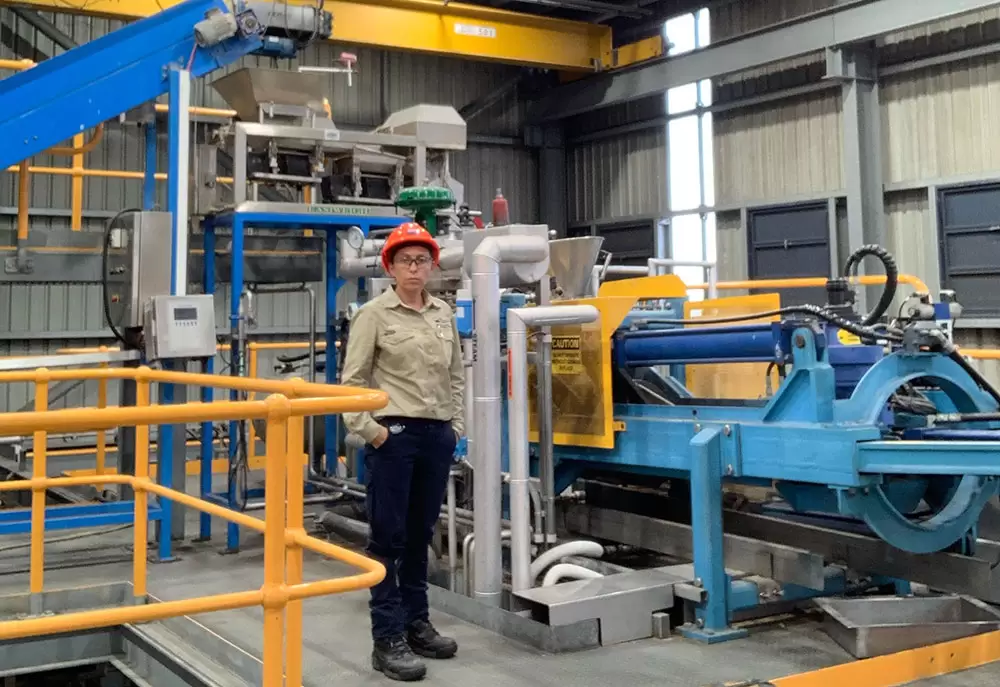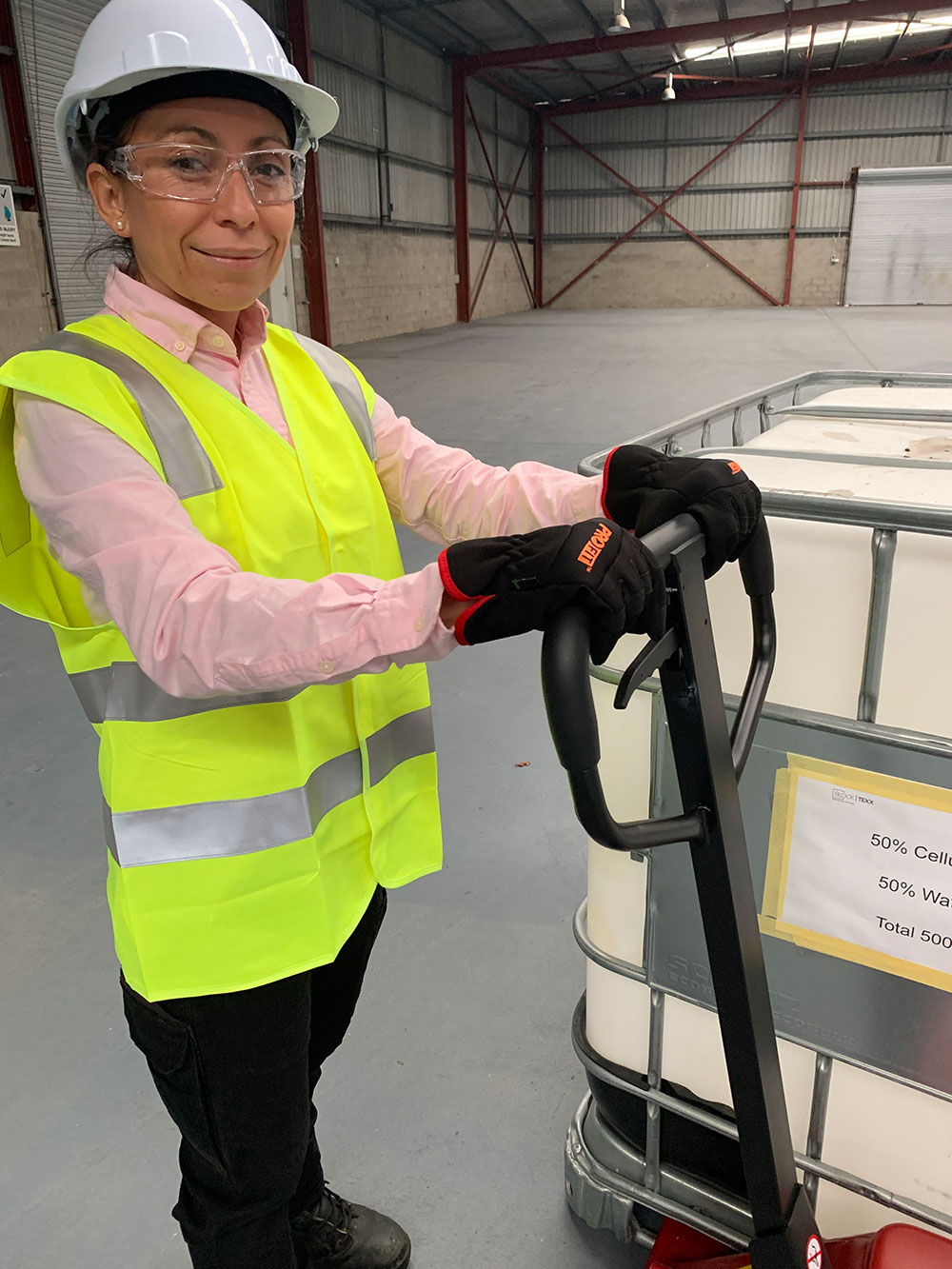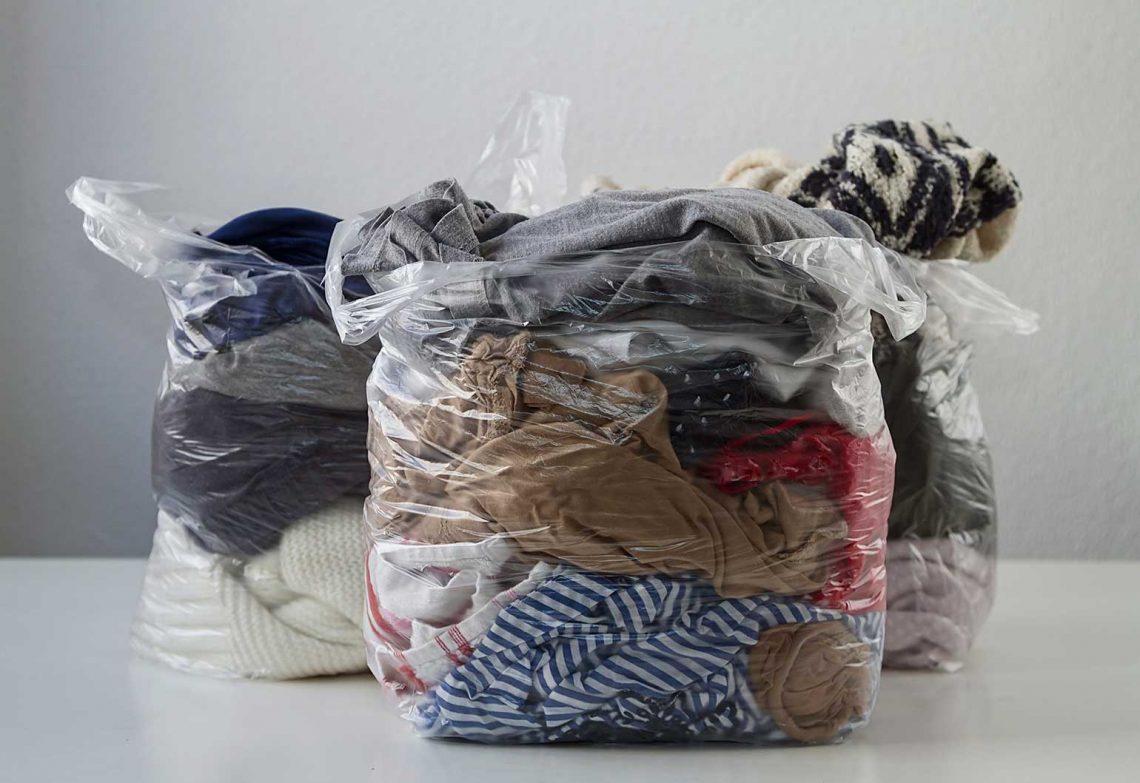At a new facility in South East Queensland, innovative textile recovery processes will help reduce landfill pileup by turning worn-out fabric into raw materials.
Australians are the world’s second-largest consumers of new textiles, behind the United States. Many of these goods end up in landfill, with the Australasian Circular Textile Association estimating nearly one million tonnes of leather and textiles are sent to landfill in Australia each year, with the average Australian contributing close to 40 kilograms of waste.
Globally, an estimated 92 million tonnes of textiles are sent to landfill each year.
At a national roundtable on textile waste hosted by Federal Minister for the Environment Sussan Ley in May, fashion industry leaders agreed a circular economy, in which textiles are reused and recycled, was critical to combat the issue.
“We want to keep clothing out of landfill, where it can take hundreds of years to break down, releasing harmful carbon emissions along the way, and we do not want to bombard our charities with clothes that are not fit for reuse,” Ley said.
“Clothing charities can be a great place to thrift shop, but they are not the place to send our tatty, pre-loved clothes that are barely hanging by a thread, and no amount of ‘wishcycling’ will change that.”
But the mixture of different natural and synthetic fibres in blended textiles makes effective recycling difficult.

This is something clothing and fashion industry veterans Graham Ross and Adrian Jones set out to change when they founded BlockTexx, with a mission to transform old textiles into a valuable commodity.
In 2018, they began working with researchers at the Queensland University of Technology (QUT) to create a process that could separate the cotton and polyester commonly found in clothing. The result was a chemical separation process called SOFT (separation of fibre technology), which turns cotton to cellulose and polyester to flake for industrial uses such as injection moulding.
The patent-pending technology will be used at BlockTexx’s new facility in Logan City, which is set to commence commercial-scale operation in early 2022, after the startup raised $5.5 million through private investment and government funding to bring its vision to life.
Chemical engineer Karen Cardona was recently appointed BlockTexx General Manager – Engineering and Technology and will oversee the new facility. She is currently setting up the operations and procedures at the plant, including managing trials with suppliers, working with project delivery partners and assisting the executive team with business development.
Getting everything up and running is a “very big job”, Cardona told create, but one she is passionate about.
“The proof of concept for the facility and its operations is coming together nicely, and in our minds it can’t come quickly enough,” she said.
“To make real impacts right now, we need to move with urgency and are preparing all the resources and planning to allow us to have those impacts as quickly as possible.
“As you read this, tonnes of textile waste are being sent to landfill, so the sooner we can get these processes going, the better tomorrow we face.”
Recovering and reusing raw fibres
The Logan facility is expected to recycle 4000 t of textile waste through the SOFT process during its first year of operation, which BlockTexx says will offset about 120,000 t of CO2 equivalents.
“BlockTexx focuses on the component materials in discarded clothing, sheets and towels, which are predominantly made from polyester and cotton. Our process recovers these raw fibres so they can be reused,” Cardona said.

“The repurposing of these fibres ensures they get a second life across a variety of new products, spanning textiles, packaging and building products.”
Cardona, who will commission the build for the facility, said “customised engineering equipment” will be needed to deliver the scale required.
“I can see how it all needs to be structured — from the management of facilities and working with consultant engineers in considering where everything will fit and how all elements will be well resourced, through to developing policies and processes including risk assessment, hazard identification, standardised safety procedures, incident reporting and communication flows,” she said.
Although the company is starting small, the aim is to scale up, with the BlockTexx team envisaging licensing the technology globally.
“We’re in a unique position to make a real impact,” Cardona said.
“This is the first time this industry has seen a commercial-scale solution that creates a true circular economy.”
A no-waste mentality
Cardona grew up in Guatemala, where she says her family was “always appreciative of what we had”.
“We didn’t have a wasteful mentality. If we had chickens, we knew they would feed us and realised the sacrifice. We grew a lot of food, shared food and took pride in composting,” she said.
“We had three generations living close by and shared clothing between the houses. When you grew out of something, it went to another member of the family and many pieces were unisex.”
Today, Cardona has more than 15 years of experience in both chemical and industrial engineering roles across the ethanol, mining and sugar industries. It was during her time in mining that she developed a greater passion for the circular economy.
“The mine I worked for had ceased operations and I remember going up to the peak and looking down over the earth and feeling a sense of devastation,” she said.
“‘What have I done?’, was all I could think.”
From then, Cardona knew she wanted a job where she could use her engineering skills to make a positive difference to the planet.
“I had that vision of the mine in the back of my head and knew that to make impacts over the next 5 to 10 years, I needed to pair with a business that matched my time, energy and passion in bringing things together for measurable change,” she said.
“That’s what I’m doing with BlockTexx now — realising the full potential of proven research and transforming that into commercially viable processes that will reduce textile waste.”




Great to know this is happening at last, and I look forward to seeing it also done in Africa (where most of the clothing waste currently ends up).
Also I see their solution involves separating the polyester out. I’d previously wondered if instead of doing so, it would be possible to dissolve it all and produce a rayon-polyester copolymer? But I’m civil not chemical, so I wouldn’t be at all surprised if the answer’s no.
Aidan, the S.O.F.T. (separation of fibre technology) process recovers both the polyester and the cotton from the blended materials. The polyester is melted and pelletised. These pellets can then be remanufactured into fibres. The cotton is manufactured into cellulose powder for reuse.
It takes a woman with vision. So glad this will soon be up and running as it always worried me about the amount of clothes being sent to op shops that really weren’t suitable for resale.
Yes…you are absolutely right. It is a massive burden for charity shops in time and cost of disposal of unusable clothing. Looking forward to hearing more about this much needed venture.
Terrific project . Looking forward to when it is underway
Wonderful idea
GOOD OLD STUFF ! I KNEW THERE HAD TO BE A BETTER WAY. Could I invest in this Company please ?
I have scraps of fabric left over from craft. Can you use these?
Hi Jennifer,
The facility will initially focus on commercial textile waste, for example, old linen from hotels, rather than contributions from the public.
Best,
create team
Hi ,what about large quantities of lint from a commercial laundry ,would this be able to be recycled.
Other organisations can use these until there is a recycling option such as Sewing for Charuty Australia, kindys, schools, craft groups at community centres and more.
Fabulous idea.
Do you have an address I can send some old clothes to. I am in Melbourne
I believe there is a company in Victoria called Upparel that will pickup clothing for recycling for a small fee, doing a similar thing.
Hi Anna,
The facility will initially focus on commercial waste, for example, old linen from hotels and textiles from Salvos Stores, rather than contributions from the public.
Best,
create team
I was very pleased to read this was happening as i dislike putting old clothes in the garbage bins
Wonderful. Much needed, good.luck with this endeavor.
Wonderful initiative and a first for Australia
CEO a women. wonderful!!. Best of everything for this leading edge project Happy to know it’s in Queensland
Cannot wait!! Need more information: address cost etc please
I bet the Indonesians will be pleased if we stop sending our dirty cast-offs for them to pay to put onto their landfill!!
I’m just wondering what kind of bi product is left over from this process and where does it go?
Also is this process environmentally friendly.
These are things that I think would have been beneficial to have in your article.
It’s a wonderful idea if the complete process is of benigit to our environment and carbon footprint.
Thankyou
There is no bi-product from the S.O.F.T. (separation of fibre technology) process. In regards to environmentally positive impact, for every kilogram process, approx. 29kg of CO2 equivalents are offset.
Excellent and necessary work done by researchers at the Queensland University Technology, aa d dealing with a massive problem.
“It is a massive burden for charity shops in time and cost of disposal of unusable clothing” ……it’s 100% true.
It’s really a very good idea.
Is there any chance to put a small investment in the Company please.
Can you please provide a link or explain how we can drop the clothing off or if there are collection points around the city. I am at Wynnum.
Hi Janelle,
The facility will initially focus on commercial waste, for example, old linen from hotels and textiles from Salvos Stores, rather than contributions from the public.
Best,
create team
Excellent job to save environmental.
Absolute BEST news… I’m filled with dread each time I send clothing to already bursting-at -the-corners op shops.
BRAVO, BRAVO, BRAVO
I agree it’s a great project but you seem to need mining as well. Without the machines it would be impossible to produce anything .
Were can we take our clothing we live in Perth W A.lena
Fantastic. I’ve always despaired of the amount of clothes lying around charity bins that are overflowing. Hopefully you will be able to expand in the future to accept discarded clothes and fabric from households. Well done.
I am keen to know more about the SOFT process and if the chemicals are harsher treatment of the environment than putting the used fabric into landfill. I sincerely hope this business is environmentally conscious and if so, that they may a great success keeping fabric out of landfill.
Finally!
Good thinking- Good work – Good luck!
Great news, we need a BlockTexx facility in each state, just can’t keep dumping our waste offshore!
Great that a recycling initiative for the vast quantities of textiles which usually end up in landfill has been developed.
What a brilliant idea ? it will be great to be able to reuse these clothing so they don’t end in landfill
Wonderful to read of this innovative technology helping to reduce and reuse our textile waste ! Well done Qld uni of tech. We hope to her more on this front as you progress in this commercial venture!
Great, only if it uses the unrecyclable stuff. Towels and cotton from hotels may be in good condition. We need massive rag, torn leather and synthetic shoe collections.
Is it worthwhile to start keeping our household materials now ? how long do you anticipate it will be before you will be able to use it Renata
This is a Great Idea.. many years ago, old cotton used clothing, was shredded & used as filling in what we called padded Eider Downs. (like today’s bed quilts). The Eider Downs, using the separated cotton, could be used to keep some of the World’s Homeless & Poorer Peoples warm in Winter.
Great news. We need one of these Facilities in each state.
I did see rags used to fill a punching bag which I thought was a good idea.
Should we start saving our unusable clothes now?
This is such a fantastic idea would love to see a video on how the procedure is done very interested on how it all turns out please
Certainly a step in the right direction.
In these early stages, it is obviously limited to commercial sources, close by. Would be wonderful if it were to grow to be all around the country, saving transport miles, and particularly expand to include the clothing and fashion sectors which are so wasteful. I wonder how much support your research has received from our current gov’t, or if it is left to commercial, backing only, or if universities are able to provide funding for such innovative research. Is there much support for ongoing, research and development and start up development.
Good luck. There is so much potential in these kind of developments.
What a long overdue solution to waste material. I hope this will be an economically sustainable project. I also look forward to perhaps buying fleecy material made from recycle cotton. I bought some in a material shop this year, by end of season it was all gone, not like some of the synthetic product still on the shelves. Please keep the community inform of your development . We are interested and concerned.
What a long overdue development. I hope this will be an economically sustainable development project that will support both you and the community.
I have been searching for a company that does exactly this for some time now. Well done! Will you look to take on the unsaleable items from charity stores all over the country? Do you have a community engagement department at this point of the startup and are you accepting EOI’s?
Wonderful. Hope you get to scale up but please also remember that smaller places, like Darwin where I live, also need this technology.
So, where can we put our unwanted textiles? Are you going to supply collections areas (bins etc)?
that’s right, is one way, of course there are others and only we would see the results when it can be compared, but these ideas have to realized, as we have , the worldwide, a very, very big problem.
Just a question, you talk regarding to separate both cotton/pes or wool/pes in individual components, however what happens with the ( unfortunately often) mixture with our big friend ( and also in the meantime enemy) elasthan?